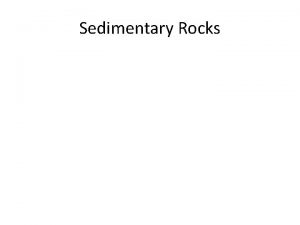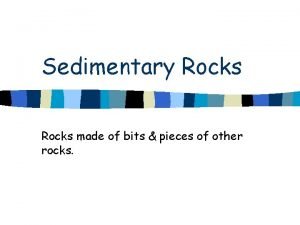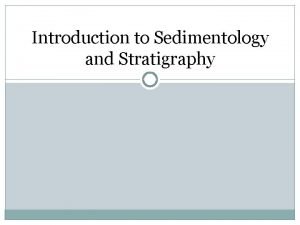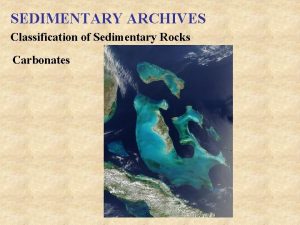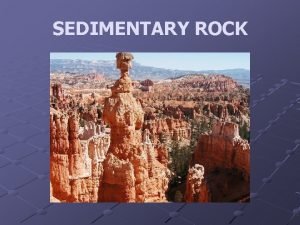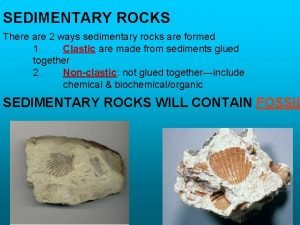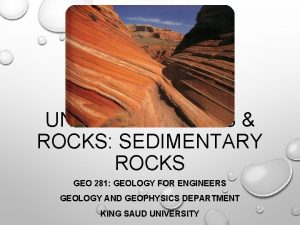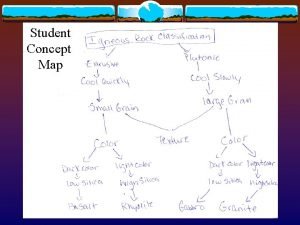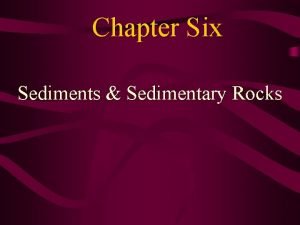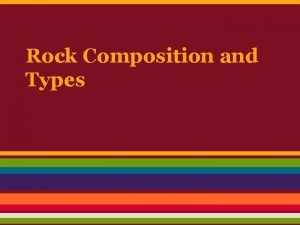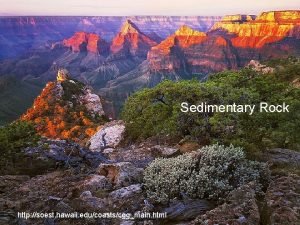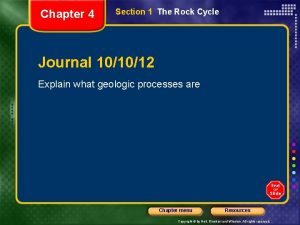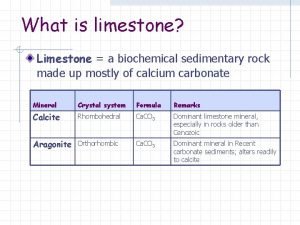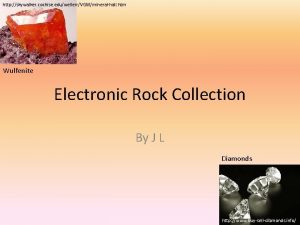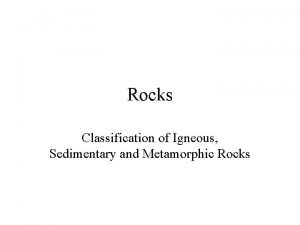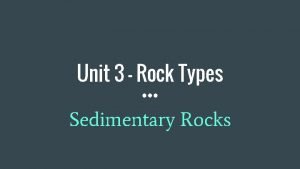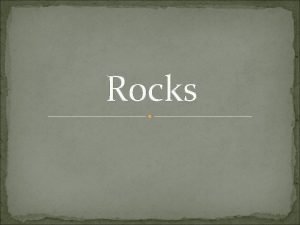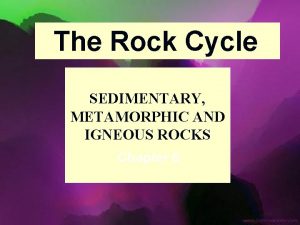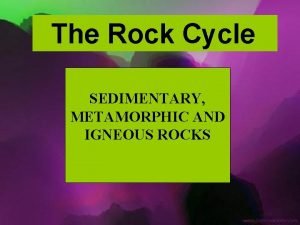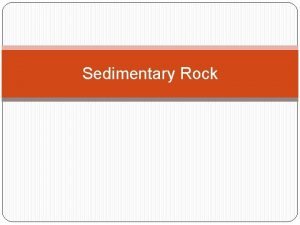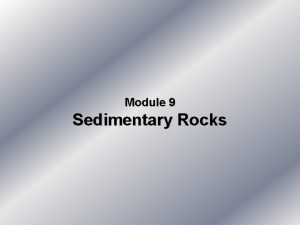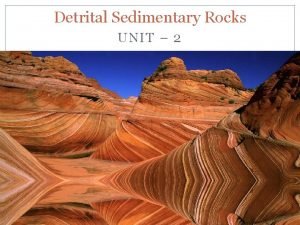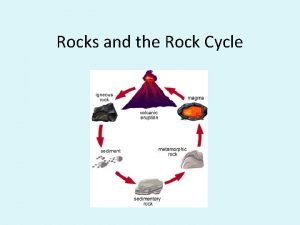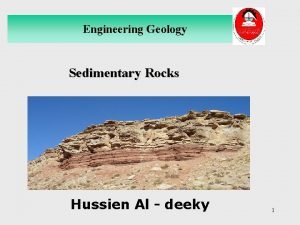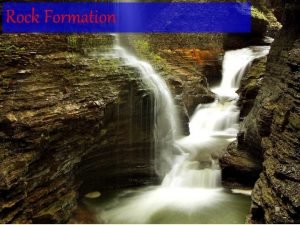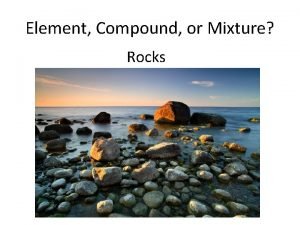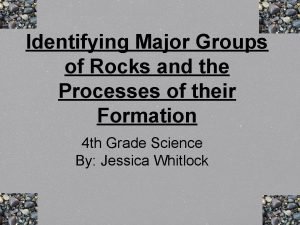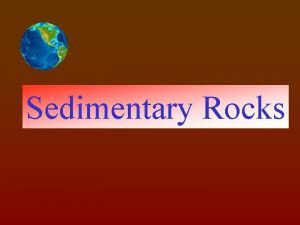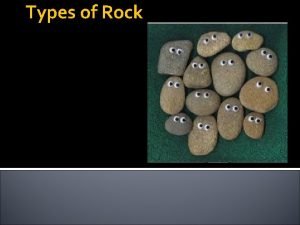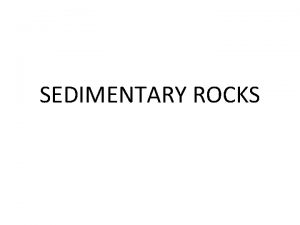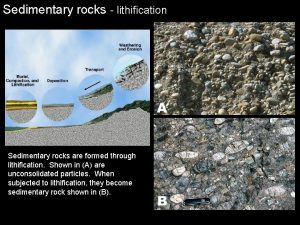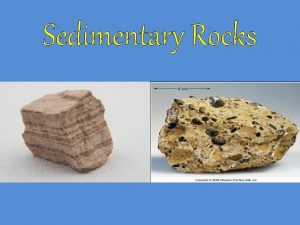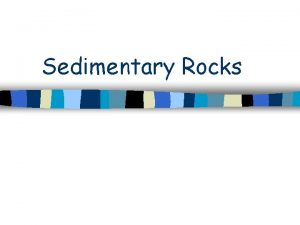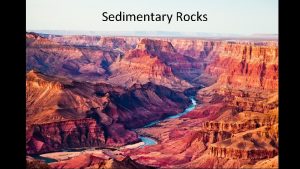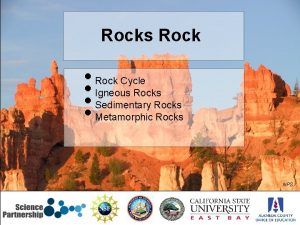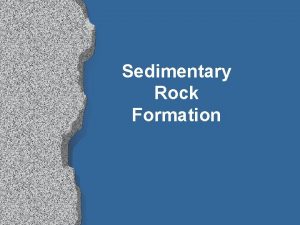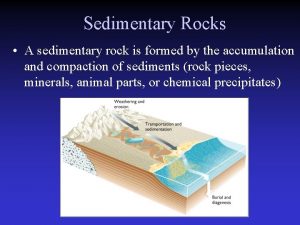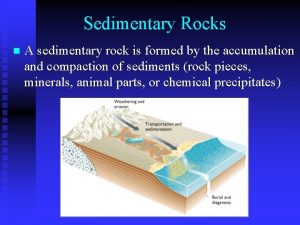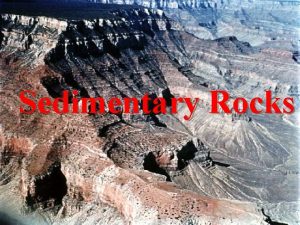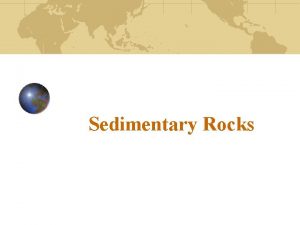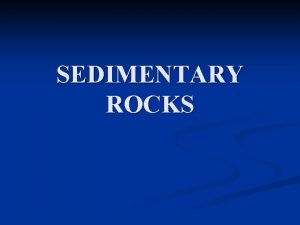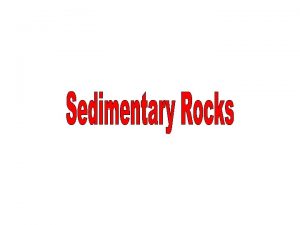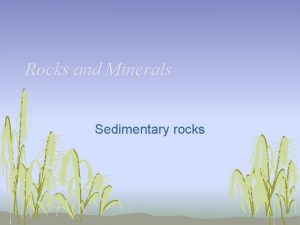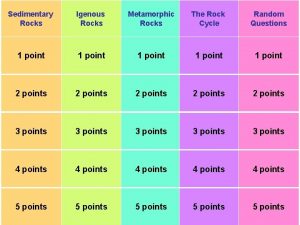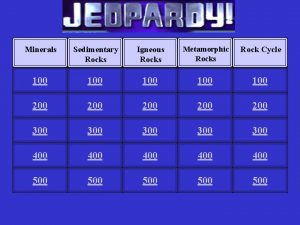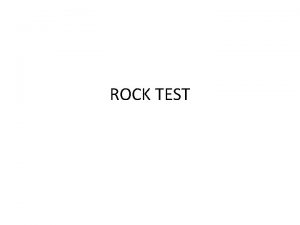Sedimentary Rocks COPY ME Sedimentary Rocks rock formed















































- Slides: 47

Sedimentary Rocks

COPY ME Sedimentary Rocks: rock formed when sediments become pressed or cemented together

COPY ME ✱ Sediments: loose materials such as rock fragments and mineral grains that have been transported by wind, water, or glacier ✱ Weathering: the breaking of rocks into smaller pieces, either mechanically or chemically ✱ Erosion: the process that moves weathered rocks from one location to another ✱ Deposition: the buildup of sediments on the bottoms of lakes, valleys and the ocean floor usually in layers

COPY ME ✱ Compaction: is when sediment becomes compressed by the weight of layers above them ✱ Cementation: is when sediments are glued together by minerals deposited between the sediments

Three types of Sedimentary Rocks: COPY ME ✱ Clastic Sedimentary Rock: made of broken fragments of plants, animals, and primarily other rocks

Examples of Clastic Sedimentary Rocks Conglomerate- composed of rounded, pebblesized fragments that are held together by a cement

Examples of Clastic Sedimentary Rocks Breccia - composed of angular, pebble-sized fragments that are held together by a cement

Examples of Clastic Sedimentary Rocks Sandstone – composed of small mineral grains (usually quartz) that are cemented together.

Examples of Clastic Sedimentary Rocks Shale – made of flaky clay particles that compress into flat layers

COPY ME Chemical Sedimentary Rocks made from minerals precipitated from a solution or are left behind when a solution evaporates – minerals left behind from rocks are evaporites Rock salt (halite) →

COPY ME ✱ Organic Sedimentary Rock primarily made from the remains of once living things

Examples of Organic Sedimentary Rock ✱ Limestone ✱ Fossiliferous Limestone ✱ Chalk

Example of Organic Sedimentary Rock Coal - forms from plant remains that are buried before they decay. The plant layers are then compacted into matter that is composed mostly of carbon


Igneous Rocks

Igneous Rocks: rock formed when magma or lava cools

✱ Lava: molten rock from a volcano flowing on Earth’s surface ✱ Magma: molten rock beneath Earth’s surface ✱ Intrusive: igneous rocks that form below Earth’s surface (plutonic) ✱ Extrusive: igneous rocks that form when magma extrudes onto Earth’s surface and cools as lava (volcanic)

✱ Above ground = from lava (extrusive igneous rock) ✱ Usually have SMALL or NO crystals (they cooled too quickly )


V. Igneous Rocks (cont) B. Extrusive Examples Basalt Rhyolite Vesicular Basalt

V. Igneous Rocks (cont) Intrusive (Plutonic) – forms below surface (inside) -Slow Cooling -Large Crystals -Coarse Texture

V. Igneous Rocks (cont) C. Intrusive Examples Gabbro Pegmatite Granite

V. Igneous Rocks (cont) D. Naming Igneous Rocks – based on composition, texture, color and density

Igneous Rocks ✱ Basaltic or Mafic: dark-colored igneous rocks that form from magma rich in iron & magnesium (high ferromagnesium minerals; low silica) ✱ Granitic or Felsic: light-colored igneous rocks, form from magma rich in silicon and oxygen (low ferromagnesium minerals; high silica)

Igneous Rock Textures A rock’s texture depends on the - size, - shape, and - arrangement of crystals A crystal’s size and shape depends: - rate of cooling - amount of dissolved gasses

SAMPLE PROBLEM. Draw a line to illustrate the relationship between crystal size and rate of cooling in igneous rock formation.

✱ Coarse Grained Mineral grains large enough to be seen with the unaided eye (Phaneritic): Granite or Gabbro

Fine Grained ✱ Mineral grains too small to be seen with the unaided eye (Aphanitic): ✱ For example: Rhyolite or Basalt

Glassy ✱ Cooled so quickly that no crystals were able to be formed Obsidian or Pumice Scoria

Porphyritic Texture Displays two stages of cooling… slow and then fast (or quenched)


SAMPLE PROBLEMS. Granite: Intrusive or Extrusive? Why? Obsidian: Intrusive or Extrusive? Why?

Metamorphic Rock

Metamorphic Rock: rock formed from existing rock when the temperature or pressure changes


Textures of Metamorphic Rocks ✱ Foliated: a texture of metamorphic rock, created when mineral grains flatten and line up in parallel bands ✱ Nonfoliated: texture of metamorphic rock, created when mineral grains change, grow, & rearrange but don’t form bands

How are metamorphic rocks classified? ✱ Non-Foliated—No bands are formed ✱ Example: marble formed from limestone

Rocks Transformed Limestone Shale Marble Slate

Rocks Transformed Sandstone Mudstone Quartzite Schist or Gneiss

Local Metamorphism ✱ metamorphism that affects relatively small volumes of rock (less than 100 km³)

Regional Metamorphism ✱ metamorphism that affects thousands of (km³) cubic kilometers of rock

Contact Metamorphism metamorphism where temperature is the primary agent ←Limestone ←Marble ←Basalt ←Marble ←Limestone http: //academic. brooklyn. cuny. edu/geology/grocha/monument/images/metheat. gif

Dynamic Metamorphism http: //www. indiana. edu/~g 103/G 103/wk 5/week 5. htm metamorphism where pressure is the primary agent (aka deformational metamorphism)

Result of Dynamic Metamorphism

http: //www. indiana. edu/~g 103/G 103/wk 5/week 5. htm

Examples of Metamorphic Rocks ✱ Gneiss – metamorphosed granite, displays foliation and banding; a result of high grade metamorphism (foliated texture) kinked gneiss →

Examples of Metamorphic Rocks ✱ Slate – pressure exerted on shale (claystone/ mudstone) http: //library. thinkquest. org/05 aug/00461/images/slate. jpg ✱ Schist – high heat and pressure exerted on slate (both with foliated texture) http: //www. windows. ucar. edu/tour/link=/earth/geology/images/Schist_mica_jpg_image. html
 Sedimentary igneous and metamorphic
Sedimentary igneous and metamorphic Igneous rock to metamorphic rock
Igneous rock to metamorphic rock Rocks formation
Rocks formation How is chemical sedimentary rock formed
How is chemical sedimentary rock formed What are sedimenta
What are sedimenta How are sedimentary rocks formed
How are sedimentary rocks formed Sedimentary rock formation
Sedimentary rock formation Earth systems 3209
Earth systems 3209 2 ways sedimentary rocks form
2 ways sedimentary rocks form How are sedimentary rocks formed
How are sedimentary rocks formed Chemical sedimentary rocks formed
Chemical sedimentary rocks formed Kinds of rocks
Kinds of rocks Concept map of classification of rocks
Concept map of classification of rocks Concept map of sedimentary rocks
Concept map of sedimentary rocks Lithification
Lithification Characteristics of sedimentary rocks
Characteristics of sedimentary rocks Marble cleavage
Marble cleavage Grain size chart
Grain size chart Soest hawaii
Soest hawaii Characteristics of sedimentary rocks
Characteristics of sedimentary rocks Chapter 4 section 3 sedimentary rock answer key
Chapter 4 section 3 sedimentary rock answer key Is limestone biochemical
Is limestone biochemical Orange sedimentary rock
Orange sedimentary rock What are sedimentary rocks
What are sedimentary rocks Metamorphic
Metamorphic Rock cycle sedimentary
Rock cycle sedimentary Coral sedimentary rock
Coral sedimentary rock Igneous
Igneous Rock cycle song for kids
Rock cycle song for kids It was a sedimentary rock song
It was a sedimentary rock song Sedimentary rock
Sedimentary rock Clastic sedimentary rocks
Clastic sedimentary rocks Detrital
Detrital Sedimatry rock
Sedimatry rock Rock cycle
Rock cycle Sedimentary rocks
Sedimentary rocks Clastic sedimentary rocks
Clastic sedimentary rocks Properties of sedimentary rocks
Properties of sedimentary rocks Is soil a element compound or mixture
Is soil a element compound or mixture Attritiom
Attritiom Sorting sedimentary rocks
Sorting sedimentary rocks Sedimentary rocks turn into metamorphic
Sedimentary rocks turn into metamorphic Transportation in sedimentary rocks
Transportation in sedimentary rocks Non banded grains
Non banded grains Sedimentary rocks leaving cert
Sedimentary rocks leaving cert Clastic chemical and biochemical sedimentary rocks
Clastic chemical and biochemical sedimentary rocks In sedimentary rocks lithification includes
In sedimentary rocks lithification includes Landslides moving water wind and glaciers cause
Landslides moving water wind and glaciers cause


